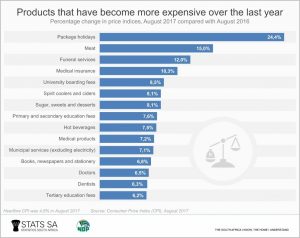Digging deeper into your pocket? These prices might be to blame
Does that braai pack feel a bit expensive? If you’ve recently noticed a rise in meat prices, then you’re not alone. Let’s take a closer look at that, as well as other items in the consumer price index with inflation higher than South Africa’s inflation target of 3–6% that is used for monetary policy.
In a recent article, Stats SA covered the surprising fact that some prices have fallen during 2017, such as the ones for rusks, vegetables, fruit, household appliances and furniture1. In this follow-up piece the flip side is explored, except that we will consider price changes between August 2016 and August 2017, and more specifically those that were above 6%2.
The annual inflation rate for meat climbed to 15% in August 2017, which is the highest it has been since December 2011. A juicy beef fillet would have set you back R194 per kilogram, up from R173 in August last year. Over the same period the average price of a kilogram of beef mince rose by 13,2% (from R68 to R77), and the annual inflation rate for mutton loin chops was 17%.
Why is the price of your favourite boerewors on the rise? When a severe drought strikes, meat prices tend to go through two distinct phases. Initially, farmers flood the market with herds that they can no longer sustain, stabilising the price of meat (and in some cases, driving prices down).
This reprieve is short-lived, however. As a drought wanes and recovery begins, it takes a while for farmers to rebuild their herds. During this time, prices go up as supply is unable to meet demand (remember those supply and demand curves from Economics 101?).
In the thick of one of the nation’s worst droughts in recent history, average meat prices either fell or were unchanged (month-on-month) in five months during 2015. That was the driest year on record since 1904 when rainfall measurements began3. By December 2015, annual meat inflation had eased to 4,1%. Again in 2016 there were also five months in which monthly average meat prices either fell or were unchanged. However, as drought conditions receded, annual meat inflation reached 7,6% by December 2016 and 15% by August 2017.
There is a possible silver lining to this bad news, however. In stark contrast to meat, vegetables and fruits were cheaper in August than a year ago. So if you’re considering cutting out red meat from your diet in favour of potatoes and bananas, now is a good time. It will be healthier for your budget too.
Apart from meat, there were three other food and drink items with prices above-target inflation in August 2017. These were sugar, sweets and desserts (8,1%), hot beverages (mainly tea and coffee) (7,5%), and spirit coolers & ciders (8,1%).
How about the others? Important items in health and education exceeded the inflation target in August. Medical insurance (medical aid) was above target at 10,3%, as were doctors (6,5%), dentists (6,3%) and medicines (7,2%). All the main education related categories were above target, namely primary and secondary school fees (7,6%), tertiary education fees (6,2%) and university boarding fees (8,5%).
The rest of the culprits are shown in the diagram. Top of the list is package holidays (travel and accommodation deals in South Africa) at 24,4%, but then these prices are volatile and August’s outcome was largely the result of a low base in August 2016. Funeral costs have exceeded the inflation target since October 2016, and in August 2017 they were up by 12% from August 2016.
Headline consumer price inflation, which is a weighted average of the many goods and services whose prices that Stats SA collects, has been within the inflation target of 3–6% since April 2017. In August 2017 it was 4,8%.
Across the globe, CPIs are amongst the most closely watched and used economic indicators, and South Africa is no exception. The headline number gets all the attention, but digging into the details is where we find the interesting stories. On Wednesday, 18 October 2017, Stats SA will release CPI figures for September 2017. So watch this space!
1 Falling prices: the good, the better, and the best (read here).
2 Download the latest inflation figures in the Consumer Price Index (CPI) release here.
3 South Africa suffers driest year on record in 2015 (read here).


